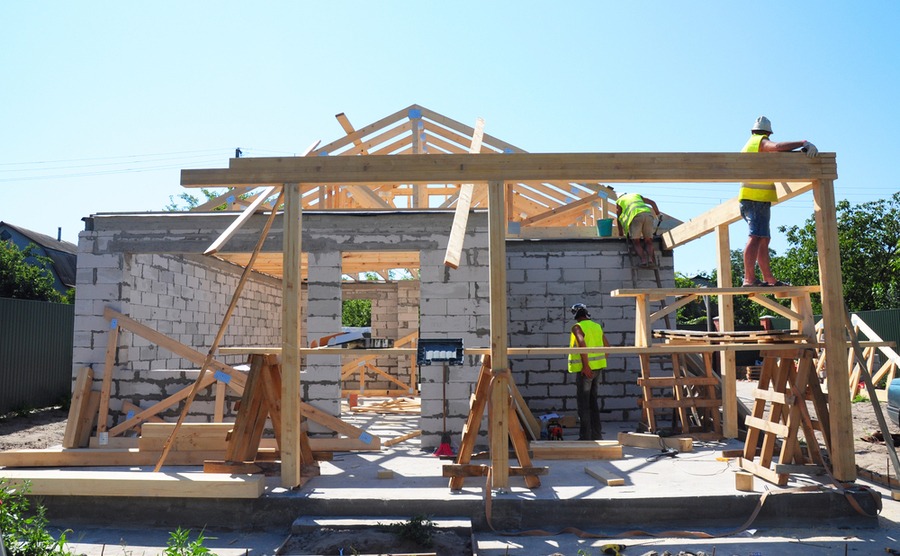Could you build your own UK home? Plenty of us have been inspired to do so and an online community of self-builders will be ready to help you along the way. In this article we offer a few tips on planning, finding professionals, and costing your project.
Whether you’re inspired by Grand Designs or just unable to find your perfect home on Rightmove, it can certainly be a wonderful idea to build your own dream home to your own specifications. However, before you can get to work sketching out designs and working out where to put walk-in wardrobes, it’s important to understand the steps involved if you want to buy land to build on in the UK.

Where will you find a plot to build in the UK?
Am I allowed to buy land in the UK?
The first question is the easiest to answer. You are. Anyone, unless limited by sanctions, can buy land to build on in the UK. You are not required to have UK citizenship to buy land here. However, getting permission to build on it is another matter. Overseas buyers may have the right to buy land, but land with planning permission to build can be hard to find. Do not buy land for building without having a very good lawyer in your corner.
Where do I find the land?
Begin your search for a plot on the internet via land sale portals. We would always recommend Rightmove, who have thousands of buildable plots available. Occasionally they feature vacant plots, but often the plots the auction houses sell will require demolition of current properties.
Additionally, contact estate agents in your chosen area, they will know about all the best plots on the market. Local architects and surveyors can also be a handy resource as they find out about plots for sale long before everyone else.
You can choose to adopt a more proactive approach simply by visiting the area and having a look around. Are there any sites with potential? How about if you were to knock down an existing property? Get chatting to locals – they might know where there is land for sale, who owns it, or who might be tempted to sell off some of their own.
Always contact your local council. They are a hugely valuable resource as every council in the UK publishes details of planning applications within their constituency. Those who are applying for planning permission aren’t necessarily applying for themselves. Many will be using their expertise in planning to find the plots to sell on to experts in building.
Working with professionals
When embarking on a building project, especially one as vital as building your home, it can be helpful to choose professionals who are members of professional bodies. For example. an estate agent registered with the National Association of Estate Agents (NAEA), and a chartered surveyor – who you must employ to establish whether the land is fit to build on – who is a member of the Royal Institution of Chartered Surveyors (RICS). Check out their handy search portal.
You will also need an architect and a builder (unless you have the skills to complete the job yourself). Professional bodies to look up here can include architect who are registered with the Architects Registration Board (ARB) and builder listed with the Federation of Master Builders or the National Federation of Builders (NFB).
In the past, the best advice would be to source quotes for the required work from at least three different professionals. However, this isn’t always possible with huge projects as builders are understandably reluctant to spend long hours preparing quotes when they have only a small chance of getting the work.
When deciding on an architect and a builder, word of mouth is often the best recommendation. Anyone really good should have a bank of satisfied customers happy to show you their homes. Also, it’s worth doing a little due diligence online before you sign on the dotted line. Read online reviews and ask around.
Is there a self-build community in the UK?
In 2016 Right to Build legislation was passed stating that councils have a duty to grant planning permission for enough plots to meet the demand outlined on their Right to Build registers. Since this law was passed, tens of thousands have signed up. So yes, people are very interested in self-build and custom build. A number of online communities have popped up to share knowledge and to offer the support needed to those wanting to build their own home in the UK.
Build It is a popular resource – a great magazine and informative website. Also, check out Homebuilding & Renovating and Self-Build Portal – which is run by the folks at the National Custom & Self-Build Association (NaCSBA). Check out the Community Self Build Agency and the Local Self-Build Register – a service that connects self and custom builders with local authorities.

Taking shape: your home in the UK
Planning permission
You will need to be familiar with the types of plots available. Some plots are sold with planning permission in place. This may just be “outline” planning permission, which still requires you to finalise the details with your local planning authority. If planning permission isn’t in place, find the local planning officer – easy to find via the local council website – and ask them how easy it will be to obtain.
The simple rules to follow with planning officials is, firstly, to remember that they are public servants whose job is to help you and to protect the environment and the public. They work within a legal framework and are not, unlike in some countries, able to be bribed.
But that doesn’t mean that you can’t persuade them to your way of thinking or present a legal argument that they may not have considered. So with any planning matter it can be sensible to employ a specialist in planning on your side. Just search for local planning consultants online or ask around locally.
Greenfield vs brownfield
Not all plots are in the countryside. Development land divides between “greenfield” and “brownfield” sites. Greenfield has never been built on before. Brownfield sites have been built on, or currently have buildings on them.
Getting planning permission for greenfield sites can be well-nigh impossible in certain areas. For example, most cities and towns have a “green belt” – a surrounding of open fields where building is legally prevented to avoid “urban sprawl”.
Brownfield sites might be previously industrial and require specialist clean up. Greenfield sites may have trees that cannot be removed whatever you want to build there.
Restrictions and easements
Some plots will allow building, but most will have restrictions, covenants and easements that affect what you can build and where. For example, planners will want new buildings to fit the local building style. Check restrictions on height, materials, which way the property must face etc. It’s important to establish that the plot you’re buying will meet your needs and will come within your budget.
A good independent solicitor will check all this for you. They will also check for “easements”. For example, check access and rights of way. How you will access the plot once the property is built? The last thing you want is to be lumped with a “ransom-strip” where you have to pay a neighbour to use their land to access your property.
Also, you must check that there isn’t any endangered wildlife living on your plot. If someone doesn’t want you to build on that plot, they will certainly be looking for rare wildlife to persuade the council to prevent you building.
The same goes for ancient woodland, which is judged to be anything that was wooded by 1600.
Fit to build on?
Employ a chartered surveyor to inspect the plot. They will be able to establish what category the ground is and whether it’s fit to build on. They will also check for the risk of flooding, pollution and subsidence. Just because a plot looks flat, doesn’t mean it will be an easy build.
The cost of building your own home in the UK
As you may have heard, building costs have rocketed since (a) the pandemic and (b) many East European builders left the UK following Brerxit. Land copsts have also risen sharply.
The cost of a plot varies depending on size and location. Browse land sales website to get a feel for the going rate. When establishing your budget, set aside the cost of the plot plus legal fees and Stamp Duty.
To find out how much it’s likely to cost to self-build the property itself, you can use this handy cost calculator from Build It. This article breaks down the costs of building your own home in detail. Do bear in mind that with projects of this nature, things rarely go without a hitch. And where there’s hitches, there’s unexpected costs. Homebuilding & Renovating recommend setting aside 10-15% of your total build budget to cover unexpected costs.









